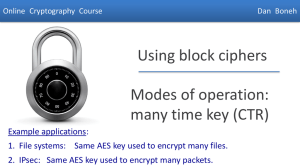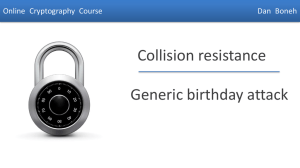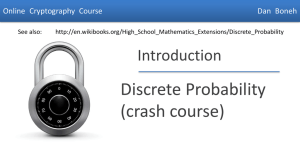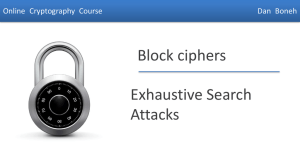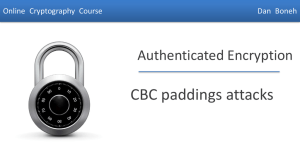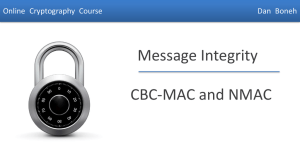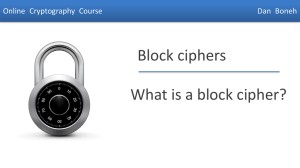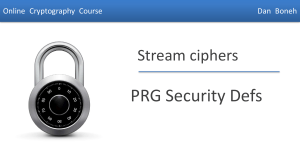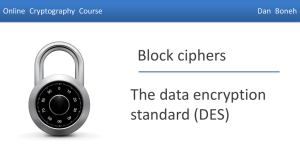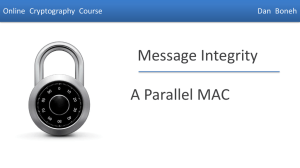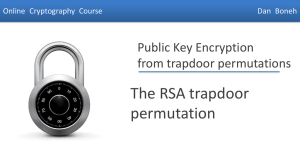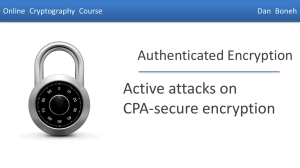many time key (CBC)
advertisement
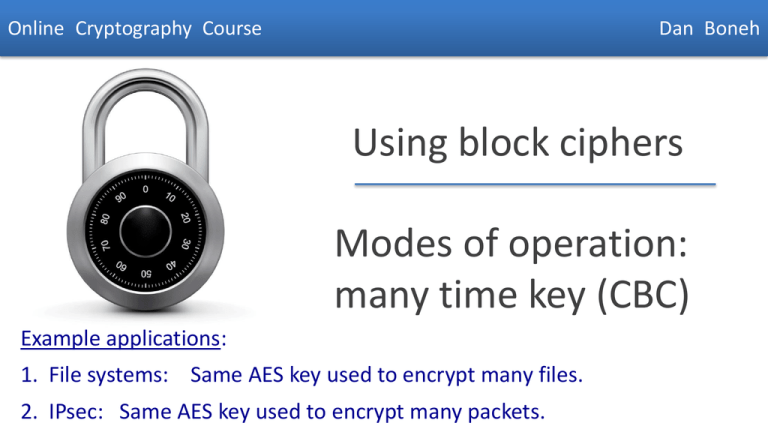
Online Cryptography Course Dan Boneh Using block ciphers Modes of operation: many time key (CBC) Example applications: 1. File systems: Same AES key used to encrypt many files. 2. IPsec: Same AES key used to encrypt many packets. Dan Boneh Construction 1: CBC with random IV Let (E,D) be a PRP. IV IV m[0] ECBC(k,m): choose random IV∈X and do: m[1] m[2] m[3] E(k,) E(k,) E(k,) E(k,) c[1] c[2] c[3] c[0] ciphertext Dan Boneh Decryption circuit D(k,) m[0] c[1] D(k,) c[0] m[1] m[0] = D(k, c[0]) ⨁ IV c[2] D(k,) IV ⇒ m[2] c[3] D(k,) In symbols: c[0] = E(k, IV⨁m[0] ) m[3] Dan Boneh CBC: CPA Analysis CBC Theorem: For any L>0, If E is a secure PRP over (K,X) then ECBC is a sem. sec. under CPA over (K, XL, XL+1). In particular, for a q-query adversary A attacking ECBC there exists a PRP adversary B s.t.: AdvCPA [A, ECBC] 2AdvPRP[B, E] + 2 q2 L2 / |X| Note: CBC is only secure as long as q2L2 << |X| Dan Boneh An example AdvCPA [A, ECBC] 2PRP Adv[B, E] + 2 q2 L2 / |X| q = # messages encrypted with k , L = length of max message Suppose we want AdvCPA [A, ECBC] ≤ 1/232 • AES: ⇐ q2 L2 /|X| < 1/ 232 |X| = 2128 ⇒ q L < 248 So, after 248 AES blocks, must change key • 3DES: |X| = 264 ⇒ q L < 216 Dan Boneh Warning: an attack on CBC with rand. IV CBC where attacker can predict the IV is not CPA-secure !! Suppose given c ⟵ ECBC(k,m) can predict IV for next message Chal. kK 0X c1 [ IV1, E(k, 0⨁IV1) ] Adv. predict IV m0=IV⨁IV1 , m1 ≠ m0 c [ IV, E(k, IV1) ] or c [ IV, E(k, m1⨁IV) ] output 0 if c[1] = c1[1] Bug in SSL/TLS 1.0: IV for record #i is last CT block of record #(i-1) Dan Boneh Construction 1’: nonce-based CBC • Cipher block chaining with unique nonce: key = (k,k1) unique nonce means: (key, n) pair is used for only one message nonce m[0] m[1] m[2] m[3] E(k1,) E(k,) E(k,) E(k,) E(k,) nonce c[0] c[1] c[2] c[3] IV ciphertext included only if unknown to decryptor Dan Boneh An example Crypto API (OpenSSL) void AES_cbc_encrypt( const unsigned char *in, unsigned char *out, size_t length, const AES_KEY *key, unsigned char *ivec, ⟵ user supplies IV AES_ENCRYPT or AES_DECRYPT); When nonce is non random need to encrypt it before use Dan Boneh A CBC technicality: padding IV m[0] m[1] m[2] m[3] ll pad E(k1,) E(k,) E(k,) E(k,) E(k,) IV c[0] c[1] c[2] c[3] IV′ TLS: for n>0, n byte pad is n n n ⋯n if no pad needed, add a dummy block removed during decryption Dan Boneh End of Segment Dan Boneh
